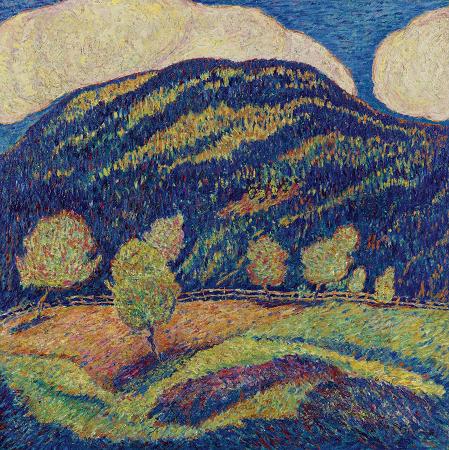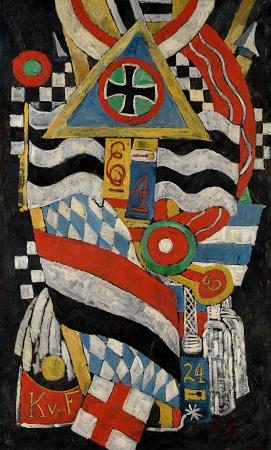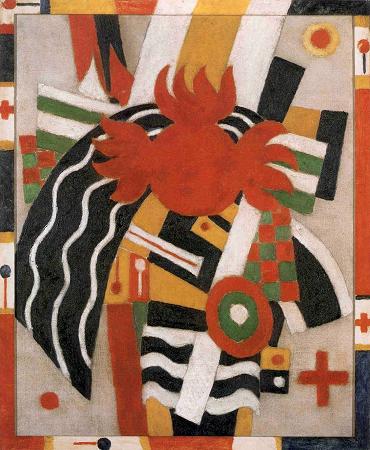Marsden Hartley (1877 - 1943). Marsden Hartley was an American Modernist painter, poet, and essayist. Hartley developed his painting abilities by observing Cubists in Paris and Berlin. Hartley was born in Lewiston, Maine, where his English parents had settled. He was the youngest of nine children. His mother died when he was eight, and his father remarried four years later to Martha Marsden. His birth name was Edmund Hartley; he later assumed Marsden as his first name when he was in his early 20s. A few years after his mother's death when Hartley was 14, his family moved to Ohio, leaving him behind in Maine to work in a shoe factory for a year. These bleak occurrences led Hartley to recall his New England childhood as a time of painful loneliness, so much so that in a letter to Alfred Stieglitz, he once described the New England accent as a sad recollection rushed into my very flesh like sharpened knives. After he joined his family in Cleveland, Ohio, in 1892, Hartley began his art training at the Cleveland School of Art, where he held a scholarship. In 1898, at age 22, Hartley moved to New York City to study painting at the New York School of Art under William Merritt Chase, and then attended the National Academy of Design. Hartley was a great admirer of Albert Pinkham Ryder and visited his studio in Greenwich Village as often as possible. His friendship with Ryder, in addition to the writings of Walt Whitman and American transcendentalists Henry David Thoreau and Ralph Waldo Emerson, inspired Hartley to view art as a spiritual quest. Hartley moved to an abandoned farm near Lovell, Maine, in 1908. He considered the paintings he produced there his first mature works, and they also impressed New York photographer and art promoter Alfred Stieglitz. Hartley had his first solo exhibition at Stieglitz's 291 in 1909, and exhibited his work there again in 1912. Stieglitz also provided Hartley's introduction to European modernist painters, of whom Cezanne, Picasso, and Matisse would prove the most influential upon him. Hartley first traveled to Europe for the first time in April 1912, and he became acquainted with Gertrude Stein's circle of avante-garde writers and artists in Paris. Stein, along with Hart Crane and Sherwood Anderson, encouraged Hartley to write as well as paint. In a letter to Alfred Stieglitz, Hartley explains his disenchantment of living abroad in Paris. A single year has passed since he began living overseas. Like every other human being I have longings which through tricks of circumstances have been left unsatisfied. and the pain grows stronger instead of less and it leaves one nothing but the role of spectator in life watching life go by-having no part of it but that of spectator. Hartley wanted to live within the noiseless countryside and an invigorating city. In April 1913 Hartley relocated to Berlin, the capital of the German Empire, where he continued to paint and befriended the painters Wassily Kandinsky and Franz Marc. He also collected Bavarian folk art. His work during this period was a combination of abstraction and German Expressionism, fueled by his personal brand of mysticism. Many of Hartley's Berlin paintings were further inspired by the German military pageantry then on display, though his view of this subject changed after the outbreak of World War I, once war was no longer a romantic but a real reality. The earliest of his Berlin paintings were shown in the landmark 1913 Armory Show in New York. In Berlin, Hartley developed a close relationship with a Prussian lieutenant, Karl von Freyburg, who was the cousin of Hartley's friend Arnold Ronnebeck. References to Freyburg were a recurring motif in Hartley's work, most notably in Portrait of a German Officer. Freyburg's subsequent death during the war hit Hartley hard, and he afterward idealized their relationship. Many scholars interpreted his work regarding Freyburg as embodying his homosexual feelings for him. Hartley lived in Berlin until December 1915. Hartley returned to the U.S. from Berlin as a German sympathizer following World War I. Hartley created paintings with much German iconography. The homoerotic tones were overlooked as critics focused on the German point of view. According to Arthur Lubow, Hartley was disingenuous in arguing that there was no hidden symbolism whatsoever. Hartley finally returned to the U.S. in early 1916. Following World War I Hartley was obligated to return to the United States. Upon his return Hartley painted Handsome Drinks. The drinkware calls back to the gatherings hosted by Gertrude Stein, where Hartley met Pablo Picasso, and Robert Delaunay. He lived in Europe again from 1921 to 1930, when he moved back to the U.S. for good.
more...














